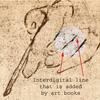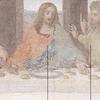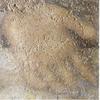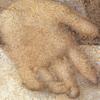
Figure 1: Drawing by J. William Littler M.D.
|
Leonardo da Vinci, nearly 500 years after his death, is once again in the limelight. Perhaps more is unknown than known about this great artist. Scholarship varies and with it, old stereotypes wax and wane. Approaching his works with a fresh view requires an open mind and a willingness to accept the transparent. During the process some revelations will be obvious, while others may be controversial. A most fortuitous revisit of his hand studies has led to the conclusion that both the weary hand sketch and the left hand of Christ in The Last Supper are examples of syndactyl or synpolydactyl hands.
Medicine and art maintain a symbiotic relationship. The human body serves as a source of knowledge and inspiration for both the physician and the artist. Leonardo's obsession with anatomy is evident in multiple drawings, including his hand studies (Leonardo da Vinci). A primitive yet perfected prehensile pentadactyl structure, the hand's inherent structure and mathematical principle allow for great adaptability and, through the brain, ingenuity (Littler 3). The inter-articular (axial) lengths in the hand follow the Fibonacci sequence of "1, 1, 2, 3, 5, 8, 13, 21, 34..." determined by Leonardo de Pisa in 1202 (Littler 8). Except for the thumb, the arpometacarpophalangeal and interphalangeal joints lengths are 8.8, 5.4, 3.3 and 2.2 centimeters (Littler 9). Noted by Leonardo, this order seen in nature and reproduced in the arts, fascinated the genius.

Figure 2A: AKA "Weary Hand Sketch" Red Chalk sketch of Leonardo's Left Hand holding a Stylus.
|

Figure 2B: It is a detail from a page Leonardo's personal notebooks known as Codex Atlanticus 770v (1512). He was about 60 when drawn.
|
The economically drawn distinctive hand holding a stylus found in the Codex Atlanticus has a history as mysterious as Leonardo himself (Codex Atlanticus, vol. 9, folio 770v, formerly folio 283 v-b) (Fig. 2A, 2B). Although casually associated with the 1517 report by Antonio de Beatis of the artist's "certain paralysis" of the right hand, it clearly appears to be a left hand (Bambach 34). Thought by some to be a mirror image portrayal of his right hand, others have concluded that Beatis may have incorrectly reported the side of Leonardo's paralysis (Todd 169). Dubbed "The Weary Hand" (Nicodemi), many have considered this to be a self-portrait, albeit crippled, arthritic, paralyzed, or stroke-traumatized (Marinoni 57, Stites 14, Richter 384). Conversations between Dr. Todd and Leonardo expert Carlo Pedretti detail a change in the dominant theory regarding the drawing (Pedretti 169). By 2003, a footnote in Bambach's paper "Leonardo, Left-handed Draftsman and Writer" relegated it to the work of a pupil (Bambach 52). The difficulty centers on piecing together several key facts: 1. Leonardo was left-handed, 2. Leonardo most likely had a stroke affecting his left brain/right hand late in life, and 3. Leonardo continued to produce some worthy drawings even after his stroke. However, if vol. 9 vol. 770v is deemed a left hand and not a crippled or paralyzed right hand, and if it is a self-representation, then the great artist may have had an unusual hand.

Figure 3A: Detail exact facsimile Red Chalk Drawing of Leonardo's Left Hand @1510; note the use of paper imperfections located where inter-digital crease would be.
|

Figure 3B: Leonardo's hand as portrayed in art books, touched up to show an inter-digital crease
|

Figures 4A & 4B: Detail of hand of the Madonna from Leonardo's Annunciation with xray of same area of that painting. Note the pointed fifth finger.
|
The stylus suggests a functioning hand. A review of licensed reproductions of the Codex Atlanticus demonstrates the use of imperfections in the paper, rather than chalk, to give the illusion of an inter-digital crease between the long and ring fingers (Licensed Codex Atlanticus) (Figure 3A). Since the original is so faint, many popular art books have "touched up" the drawing (Figure 3B), and this has lead to faulty conclusions regarding the type of hand depicted. Paralysis should produce either a flaccid hand or spastic contractures, and trauma would create a different appearance. Rather, this is a drawing of a hand with a long-to-ring finger syndactyly. Its pointed fifth finger is reminiscent of the same fifth finger seen in many of Leonardo's hands, including Mary in the Annunciation (Stites 15)(Figure 4A,B). Perhaps simply a form of artistic expression, this fifth finger is deemed by some to be a congenital anomaly potentially present in the Leonardo maternal tree (Stites 14). Is it possible that "Leo the Lion" had a congenitally anomalous left hand that was nonetheless functional and certainly not affected by a stroke later in life? Is it further possible that he was so named because of this?

Figure 5A: Leonardo's Last Supper with all Apostles. 1495 Milan
|

Figure 5B: Detail showing Christ hands outstretched.
|

Figure 5C: Detail of Left Hand of Christ prior to most recent restoration in late 1990's.
|

Figure 5D: Detail showing Left Hand of Christ after the twenty year restoration.
|

Figure 6: Sarah Felong's depiction
|
Given that "The Weary Hand" is a sketch in the Codex Atlanticus, it is reasonable to search other Leonardo works for signs of syndactyly. Examination of the hands of Christ in The Last Supper (Figures 5A-D) show that while different degrees of restoration and repair have been suffered by both, the right hand is more severely compromised than the left (Barcilon 355, 359). The current, most extensive and well-considered restoration, spearheaded by Pinin Brambilla Barcilon, has made many recoveries including an area in the left hand where "Leonardo's masterful chiaroscuro modulation is still visible, and even some pentimenti can be identified where the four fingers were shortened to accentuate their contraction" (Barcilon 359) (Figures 5A-D). The "goal of the pictorial integration was to achieve sufficient legibility of gesture, pose and modeling" based upon the intent of the artist (Barcilon 359). Each step has been microscopically detailed and documented, thus allowing future students of The Last Supper to see how the masterpiece looked before and after restoration (Barcilon 343) (Figures 6). Both pre and post-restoration, the left hand is consistent with a syndactyly situation since the resultant radial deviation of the end of the fourth finger is abnormal and slight ulnar deviation of the long finger is present (Upton). Remarkably the final result depicts more contracture than the earlier draft or pentimenti, suggesting that the final hand as painted by Leonardo was more anomalous appearing than his original brushstrokes. The presumed model for the hands of Christ was Alessandro Carissimi of Parma (Marani 227). A search of his genealogy may provide evidence that Carissimi was a syndactyl or, if not, that he was useful as a "decoy" in case Leonardo was accused of using his own hand as the hand of Christ. In either case, portraying Christ with an anomalous hand most likely would have been considered sacrilegious during this time period.
Many artists of the late 1400s/early 1500s, including Michelangelo and Sebastian del Piombo, were naturally left-handed who may have retrained themselves to be right-handed and were therefore not singled out as unusual on the basis of their handedness (Bambach 47, 48). Given the moniker "Il Mancino/The Left Handed One" (Bambach 31), Leonardo's namesake is a clawed, ferocious animal. Some suggest that he was dubbed "Il Mancino" simply because he continued to work primarily with his left hand and no mention of an anomaly is offered (Bambach 31). "La mano manca" literally refers to "the lacking or injured hand". However, according to lexicographic surveys in Battaglia, Italy from 1975 and 1998, it can also refer to the left hand (Bambach 52). "Mancare" is Italian for the verb "to need", while the Latin word "mancus" is translated as "defective in any limb" (Valpy, 248). Considered to be ambidextrous (Stites 90), the persistence of Leonardo's title may be based upon some noticeable difference in his left hand, rather than the continued use of that hand. Considered perfect by many, he was anecdotally known to wear an "audacious romantic garment with fanciful sleeves, flying into points like a girl's (Taylor 43)". Was this due simply to style preference or was it done to hide an anomalous hand?
Leonardo wrote in his notebooks: (Cod. Arundel. Folio155r) "Arching my back, I rested my tired hand (la stanca mano) on my knee and held my right hand over my lowered lids." (Brizio, 292) Written around 1478 when Leonardo was approximately 25 years old, this shows that he referred to his left hand as his tired hand much earlier than as would have been expected if it had been caused by a stroke. The subject of controversy, it is frequently translated to mean "left hand" (Brizio 292). The literal meaning of "stancare" is weary, exhausted, or tired and a review of Kate Steinitz's book "Leonardo da Vinci's Trattato della Pittura...A Bibliography" shows that John Spencer believes that the more appropriate translation is indeed "tired hand" (Spencer, 201).

Figure 7: Leonardo's most famous red chalk self-portrait aka "Turin Sketch"
|

Figure 8A: Raphael's Cartoon/large Prep sketch for "School of Athens.
|

Figure 8B: Raphael's "School of Athens", 1510 located in the Vatican.
|

Figure 8E: Detail of Plato's left hand. The painting was recently restored (late 1990's).
|

Figure 8D: Detail of the face shows the same face as Leonardo's self-portrait "Turin Sketch".
|

Figure 8C: Detail showing Plato holding his book "Timeo".
|
The figure of Plato in both the fresco and the cartoon for The School of Athens by Raphael in 1510 is generally accepted to be that of Leonardo (Stites 108) (Vasari) (Figure 8B). The right hand is demonstrated with index finger extended (Figure 8B). The left hand is flexed and holding the inferior border of a large book. In the fresco, the central two digits are obscured and normally one would expect to see the proximal phalanges next to that of the index finger. However, in this condition they are essentially hidden and cannot be commented on. The thumb is large and appears to be either deviated radially or hyper-extended at the IP (interphalangeal) joint (Upton) (Figure 8C). Good quality representations of the cartoon suggest more convincing evidence of a possible anomaly. The face of Plato resembles closely that in the infamous Turin Sketch and most likely is the same individual, i.e. Leonardo (Upton) (Figures 7,8E).

Figure 9A: Botticelli's 1475 "Adoration of the Magi", Leonardo was 23 at time
|

Figure 9C: Detail of Left hand grasping scholars' cloak. Appears consistent and could be a portrayal of a complex (osseous) polysyndactyly.
|

Figure 9B: Detail of Adoration showing man grasping his cloak with left hand.
|
Fellow artist Botticelli is suspected to have portrayed Leonardo in the 1475 Medici Adoration of the Magi (Stites 100, 101) (Bramly 343) (Figure 9A-C). On the left in a scholar's cap and cloak, standing next to Lorenzo the Magnificent, is a figure with his left hand flexed over the cloak. The two central digits, ring and long fingers, are not flexed at the PIP (proximal interphalangeal) and DIP (distal interphalangeal) joints. The fifth finger is hyper-extended at the MP (metacarpal phalange) joint, and flexed approximately ninety degrees at the PIP (proximal interphalangeal) joint. There is an inclusion of a longitudinal crease between the central two digits. Others suggest that this figure actually represents Pico della Mirandola (born 1463, 12-13 years old at the time), a famous syncretist and scholar associated with the Medici (Fletcher website). Resisting the tendency to see anomalies in all unusual extremities of the time period, this hand however could be a portrayal of a complex (osseous) polysyndactyly (Upton). (Figure 9B-9C)

Figure 10A: Botticini's Tobias the Archangel holding a sphere.
|

Figure 10B: detail showing Tobias's left hand holding a sphere. Note the pointed fifth finger.
|

Figure 11A: Michelangelo's "Leonardo holding a Skull", note the unusual left hand.
|

11B: detail Michelangelo's "Leonardo holding a Skull", note the closeup of the left hand.
|
Further review of other artists' interpretations of Leonardo is needed, including the archangel Michael in Botticini's Tobias and the Three Archangels (Nicodemi 17) (Figure 10A, 10B) and Michelangelo's drawing of Leonardo holding a skull (Stites 101) (Figure 11), to see if they give similar evidence of an unusual left hand.

Figure 12A: c1504 Leonardo's "Madonna and the Yarnwinder" (The Lansdowne Madonna)
|

Figure 12B: Detail of left hand of naked Christ.
|

Figure 12D: Close-up infra-red detail of left hand of baby Christ.
|

Figure 12C: Infra-red photo showing details under surface paint.
|
The Madonna of the Yarnwinder 1504 (The Lansdowne Madonna) (Fig.12 A, B, C, D) by Leonardo has been extensively studied, including an IR-RGB (infrared-reflectographyby the National Institute of Applied Optics (INOA-CNR) in Florence, Italy.), color scan, mixed colorwith infrared and false color) scanning. Remarkably what is seen in the IR of the infant's left hand (Fig.12C, D &13) is an uncorrected synpolydactyly after early soft tissue separation but with no skeletal correction (Upton, Clinics 332). Interpreted as pentimenti and revisions of his compositions (Universal Leonardo website), it may have been that the infant portrayed had a congenital anomaly consistent with the syndactyl left hand of Christ depicted in the Last Supper.
Pursuit of scholarship demands that all of Leonardo da Vinci's original works be revisited by experts armed with the latest technology, including perhaps genetic studies of the pertinent parties including the genius himself. "The Weary Hand" depicts a confident, functioning syndactyly hand while The Last Supper and Yarnwinder show a left syndactyly Christ. Perfection is no longer limited to the realm of the "norm".
Works Cited:
Leonardo da Vinci, 1452-1519. Leonardo on the Human Body. Dover Publishing, Inc: New York, 1983.
Littler, William, MD, Cramer, Lester, MD, and Smith, James W., MD, eds. "Adaptability". Symposium on Reconstructive Hand Surgery, volume 9. Mosby Company: St. Louis, 1974.
Nicodemi, Giorgio. Leonardo da Vinci. Instituto Geografici de Agostini:
Milan, no date.
Bambach, Carmen, ed. Leonardo da Vinci Master Draftsman. Yale Press: New York, 2003.
Stites, Raymond. The Sublimations of Leonardo da Vinci. Smithsonian Institute Press: Washington, 1970.
Barcilon, Pinin, and Marani, Pietro. Leonardo The Last Supper. University of Chicago Press: Chicago, 1999.
Marani, Pietro. Leonardo da Vinci. Harry Abrahms, Inc: New York, 2000.
Taylor, Rachel. Leonardo the Florentine. Blue Ribbon Books, Inc: New York, approx. 1909.
Spencer, John R. Review of "Leonardo da Vinci's Trattato della Pittura...A Bibliography." Renaissance News, vol. 11, No. 3 (Autumn, 1958), pp. 200-202."
Licensed Codex Arundel, Sweeney Family Collection. Folio 155r,
Licensed Codex Atlanticus, Sweeney Family Collection. Vol. 9, folio 770 v, formerly known as folio 283 v-b.
Upton, Joseph. Private collection of hand casts.
Richter, Irma, A, ed. Selections from the Notebooks of Leonardo da Vinci. Oxford University Press: London, 1952.
Vasari, Giorgio. The Lives of the Painters, Sculptors, and Architects. trans. A.B. Hinds, E.P. Dutton, New York, 1950.
Steinitz, Kate Trauman. Leonardo da Vinci's Trattato della Pittura...A Bibliography. Copenhagen: Munksgaard, 1958 (Library Research Monographs. Vol. 5).
Bramly, Sergei. Leonardo: Discovering the Life of Leonardo da Vinci. trans. Sian Reynolds. Harper Collins: New York, 1991.
Fletcher, Adrain. www.paradoxplace.com.
Raphael, School of Athens, wikipedia, http://upload.wikimedia.org/wikipedia/commons/9/94/Sanzio_01.jp
Leonardo da Vinci, 1452-1519, Madonna and the Yarnwinder. http://www.universalleonardo.org/scientificAnalysis.php?tool=544&id=313
Figure 1: Drawing by J. William Littler M.D. Of fully extended and abducted Hand,
Fingertips lie on circumference of circle having its locus at central metacarpal (III) head.
Figure 2A & 2B: AKA “Weary Hand Sketch” Red Chalk sketch of Leonardo’s Left Hand holding a Stylus. 2B: It is a detail from a page Leonardo’s personal notebooks known as Codex Atlanticus 770v (1512). He was about 60 when drawn.
Figure 3A, B: 3A: Detail exact facsimile Red Chalk Drawing of Leonardo's Left Hand @1510; note the use of paper imperfections located where inter-digital crease would be. 3B: Leonardo’s hand as portrayed in art books, touched up to show an inter-digital crease.
Figure 4: Detail of hand of the Madonna from Leonardo’s Annunciation with xray of same area of that painting. Note the pointed fifth finger.
Figure 5 A, B, C, D: 5A: Leonardo’s Last Supper with all Apostles. 5B: Detail showing Christ hands outstretched. 5C: Detail of Left Hand of Christ prior to most recent restoration in late 90’s. 5D: Detail showing Left Hand of Christ after the twenty year restoration. It was determined by the top experts that this was Leonardo’s original left hand of Christ hand as he intended.
Figure 6: Sarah Felong’s depiction showing the original under drawing of Christ’s Left hand compared to first painted depiction. It appears that he drew the hand as non-anomolous then painted it as we see it today. (A syndactyl hand)
Figure 7: Leonardo’s most famous red chalk self-portrait aka “Turin Sketch” 1512. Leonardo was one of the first to use red chalk in his drawings. Though some debate whether by him rarely is debated whether it is of him. It is consistent with other depictions Leonardo, most notably Raphael’s depiction of him as Plato in the School of Athens.
"Figures 8A, B, C, D, E: 8A: Cartoon for Raphael's "School of Athens", showing detail of Plato. 8B: Raphael's "School of Athens" (1510), located in the Vatican. 8C: Detail of Plato holding the book "Timeo". Raphael is believed to have used Leonardo as the model for Plato. 8D: Detail of the face of Plato in Raphael's "School of Athens". 8E: Detail of the left hand of Plato in the "School of Athens".
"Figures 9A, B, C: 9A: Botticelli's "Adoration of the Magi" (1475). Leonardo was 23 at the time. 9B: Detail of "Adoration of the Magi" showing a man grasping his cloak with his left hand. This figure has historically been thought to be Leonardo. However, others believe that it may actually be the famous syncretist Pico della Mirandola, who would have been only 12 at the time. 9C: Detail of left hand grasping cloak. It appears to be consistent with a portrayal of a complex (osseous) polysyndactyly."
Figures 10 A, B: 10A: Botticini’s Tobias the Archangel holding a sphere. 10B: detail showing Tobias’s left hand holding a sphere. Note the pointed fifth finger.
Figure 11A,B: 11A: Michelangelo’s “Leonardo holding a Skull”,11B: note the closeup of the left hand.
Figures 12 A, B, C, D: 12A: Leonardo’s “Madonna and the Yarnwinder” (1504) (The Lansdowne Madonna) 12B: Detail of left hand of naked Christ. 12C: Infra-red photo showing details under surface paint. 12D: Blown-up infra-red detail of left hand of baby Christ. Detail shows an uncorrected synpolydactyly after early soft tissue separation. Photo by the National Institute of Applied Optics (INOA-CNR) in Florence, Italy.
























